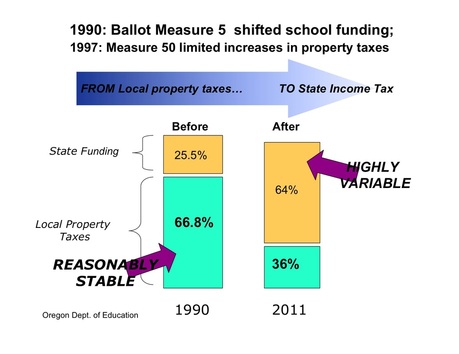Measure 5
In 1990 by a narrow margin Oregon voters modified the Oregon State constitution by passing Measure 5. Measure 5 changed the way that Oregon funds its schools. Instead of having schools funded primarily by local property taxes, Oregon schools became funded largely by state income taxes.
One big drawback of income tax as the primary source of education funding is the it isn't very stable. When the economy is in a recession funding dramatically drops. Teacher layoffs and furlough days can be the only way that districts can really respond to high volatility in district budgets.
Oregon despite having a highly volatile system for funding education uses two of the three types of taxation to fund its schools. Property taxes don't change when there is a recession, but income taxes change dramatically. Sales taxes are the third leg of a typical state revenue stool, Oregon doesn't have a sales tax and with the high reliance on income tax, funding for education is highly wobbly. Moreover, the Rainy Day fund that Oregon uses to set aside money to reduce cuts to Education in economic downturns is very small compared to the majority of other states.
Oregon despite having a highly volatile system for funding education uses two of the three types of taxation to fund its schools. Property taxes don't change when there is a recession, but income taxes change dramatically. Sales taxes are the third leg of a typical state revenue stool, Oregon doesn't have a sales tax and with the high reliance on income tax, funding for education is highly wobbly. Moreover, the Rainy Day fund that Oregon uses to set aside money to reduce cuts to Education in economic downturns is very small compared to the majority of other states.
If you would like to know more technical information about Measure 5 law look at the additional page under the Measure 5 heading.
Suggested Readings:
Smith, G. A. (February 01, 1995). Living with Oregon's Measure 5: The Costs of Property Tax Relief in Two Suburban Elementary Schools. Phi Delta Kappan, 76, 6, 452-61.
Smith, G. A. (February 01, 1995). Living with Oregon's Measure 5: The Costs of Property Tax Relief in Two Suburban Elementary Schools. Phi Delta Kappan, 76, 6, 452-61.

